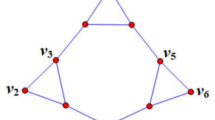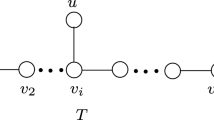Abstract
In \(\mathrm {PG}(2,q)\), the projective plane over the field \(\mathbf{F}_{q}\) of q elements, a (k, n)-arc is a set \(\mathcal {K}\) of k points with at most n points on any line of the plane. A fundamental question is to determine the values of k for which \(\mathcal {K}\) is complete, that is, not contained in a \((k+1,n)\)-arc. In particular, what are the smallest and largest values of k for a complete \(\mathcal {K}\), denoted by \(t_n(2,q)\) and \(m_n(2,q)\)? Here, a new lower bound for \(t_n(2,q)\) is established and compared to known values for small q.
Similar content being viewed by others
Avoid common mistakes on your manuscript.
1 Introduction and background
A projective plane of order q consists of a set of \(q^2+q+1\) points and a set of \(q^2+q+1\) lines, where each line contains exactly \(q+1\) points and two distinct points lie on exactly one line. It follows from the definition that each point is contained in exactly \(q+1\) lines and two distinct lines have exactly one common point.
The main focus of this paper is to find a lower bound for k of a (k, n)-arc in \(\mathrm {PG}(2,q)\). First, some basic constants and their properties are summarised. See [8, Chap. 12] or [7, Chap. 12].
Definition 1.1
A (k, n)-arc in \(\mathrm {PG}(2,q)\) is a set \(\mathcal {K}\) of k points, no \(n+1\) of which are collinear, but with at least one set of n points collinear. When \(n =2\), a (k, 2)-arc is a k-arc.
Definition 1.2
A (k, n)-arc is complete if it is not contained in a \((k,n+1)\)-arc.
Notation 1.3
The maximum value of k for a (k, n)-arc to exist is denoted by \(m_n(2,q)\).
Definition 1.4
A line \(\ell \) is an i-secant of \({\mathcal {K}}\) if \(|\ell \cap {\mathcal {K}}| =i\).
Notation 1.5
For a (k, n)-arc \(\mathcal {K}\) in \(\mathrm {PG}(2,q),\) let
Lemma 1.6
For a (k, n)-arc \(\mathcal {K},\) the following equations hold :
Proof
See [8, Chap. 12]. \(\square \)
The constants \(\rho _i,\,\sigma _i\) are useful in investigations of the properties of (k, n)-arcs, but are not required here.
Theorem 1.7
Proof
See [8, Chap. 8]. \(\square \)
Theorem 1.8
-
(1)
$$\begin{aligned} m_n(2,q) {\left\{ \begin{array}{ll} =(n-1)q+n, &{} {for}\, q\, {even}\, {and}\, n\mid \, q;\\ <(n-1)q+n, &{} {for}\, q \,{odd}. \end{array}\right. } \end{aligned}$$
-
(2)
A (k, n)-arc \(\mathcal {K}\) is maximal if and only if every line in \(\mathrm {PG}(2,q)\) is either an n-secant or a 0-secant.
Proof
See [8, Chap. 12]. \(\square \)
Lemma 1.9
If \(\mathcal {K}\) is a complete (k, n)-arc, then \((q+1 - n)\tau _n \ge q^2+q+1-k,\) with equality if and only if \(\sigma _n=1\) for all Q in \(\mathrm {PG}(2,q)\backslash \mathcal {K}\).
Proof
See [8, Chap. 12]. \(\square \)
Definition 1.10
The type of a point P in \(\mathrm {PG}(2,q)\) for a (k, n)-arc is the \((n+1)\)-tuple \((\rho _0,\rho _1, \ldots ,\rho _n)\).
2 New lower bound
A lower bound for the smallest complete (k, n)-arcs \(\mathcal {K}\) is established below.
Theorem 2.1
In \(\mathrm {PG}(2,q),\) a complete (k, n)-arc does not exist for \(k \le n^*,\) where
Proof
Let \(\mathcal {K}\) be a complete (k, n)-arc. The number of n-secants through a point P in \(\mathcal {K}\) is at most \((k-1)/(n-1)\). Then, counting the set \(\{(P,\ell ) \}\), where \(\ell \) is an n-secant and P is a point of \(\mathcal {K}\) incident with \(\ell \) gives that
On the other hand, Lemma 1.9 implies that
Now, from Eqs. (2.1) and (2.2),
Hence
Now, Eq. (2.3) implies that \(k= n^* > 0.\)\(\square \)
This can be applied to k-arcs and (k, 3)-arcs, as in Tables 1 and 2, with the notation \(n^* = b_n(2,q)\) and \(n=2,3\).
References
Bartoli D., Marcugini S., Pambianco F.: The maximum and the minimum sizes of complete \((n,3)\)-arcs in \(PG(2,16)\). In: Thirteenth International Workshop on Algebraic and Combinatorial Coding Theory, Pomorie, Bulgaria, pp. 77–82, 15–21 June 2012.
Bartoli D., Giulietti M., Zini G.: Complete \((k,3)\)-arcs from quartic curves. Des. Codes Cryptogr. 79, 487–505 (2015).
Bierbrauer J.: The maximal size of a 3-arc in \(\text{ PG }(2,8)\). J. Comb. Math. Comb. Comput. 45, 145–161 (2003).
Coolsaet K., Sticker H.: A full classification of the complete \(k\)-arcs in \(PG(2,23)\) and \(PG(2,25)\). J. Comb. Des. 17, 459–477 (2009).
Coolsaet K., Sticker H.: The complete \(k\)-arcs of \({\rm PG}(2,27)\) and \({\rm PG}(2,29)\). J. Comb. Des. 19, 111–130 (2011).
Coolsaet K., Sticker H.: The complete \((k,3)\)-arcs of \(\text{ PG }(2, q), q\le 13\). J. Comb. Des. 20, 89–111 (2012).
Hirschfeld J.W.P.: Projective Geometries Over Finite Fields, pp. xii+474. Clarendon Press, Oxford (1979).
Hirschfeld J.W.P.: Projective Geometries Over Finite Fields, 2nd edn, pp. xiv+555. Oxford University Press, Oxford (1998).
Hirschfeld J.W.P., Pichanick E.V.D.: Bounds for arcs of arbitrary degree in finite Desargusian planes. J. Comb. Des. 24, 184–196 (2016).
Marcugini S., Milani A., Pambianco F.: A computer based classification of the \((n,3)\)-arcs in \(PG(2,7)\). Rapporto Tecnico n.7 (1998).
Marcugini S., Milani A., Pambianco F.: A computer based classification of the \((n,3)\)-arcs in \(PG(2,8)\). Rapporto Tecnico n.8 (1998).
Marcugini S., Milani A., Pambianco F.: A computer based classification of the \((n,3)\)-arcs in \(PG(2,9)\). Rapporto Tecnico n.9 (1998).
Marcugini S., Milani A., Pambianco F.: Maximal \((n,3)\)-arcs in \(PG(2,11)\). Discret. Math. 208(209), 421–426 (1999).
Marcugini S., Milani A., Pambianco F.: Maximal \((n,3)\)-arcs in \(PG(2,13)\). Discret. Math. 294, 139–145 (2005).
Marcugini S., Milani A., Pambianco F.: Complete arcs in \(PG(2,25)\): the spectrum of size and the classification of the smallest complete arcs. Discret. Math. 307, 739–747 (2007).
Acknowledgements
Salam Alabdullah obtained a Ph.D. studentship funded by the Ministry of Higher Education and Scientific Research of the Government of Iraq via the University of Basra.
Author information
Authors and Affiliations
Corresponding author
Additional information
Publisher's Note
Springer Nature remains neutral with regard to jurisdictional claims in published maps and institutional affiliations.
This is one of several papers published in Designs, Codes and Cryptography comprising the “Special Issue on Coding and Cryptography”.
Rights and permissions
OpenAccess This article is distributed under the terms of the Creative Commons Attribution 4.0 International License (http://creativecommons.org/licenses/by/4.0/), which permits unrestricted use, distribution, and reproduction in any medium, provided you give appropriate credit to the original author(s) and the source, provide a link to the Creative Commons license, and indicate if changes were made.
About this article
Cite this article
Alabdullah, S., Hirschfeld, J.W.P. A new lower bound for the smallest complete (k, n)-arc in \(\mathrm {PG}(2,q)\). Des. Codes Cryptogr. 87, 679–683 (2019). https://doi.org/10.1007/s10623-018-00592-8
Received:
Revised:
Accepted:
Published:
Issue Date:
DOI: https://doi.org/10.1007/s10623-018-00592-8




